Pillar 1: We Need The Big Picture

In my previous post, I noted two concerning, and connected, trends
- Young people walking away from faith
- Biblical literacy dramatically declining among young people (and adults)
As promised, this is the first of five pillars to teach your family. That means five ways to help your family grow up to understand truth, and to walk more confidently in the faith.
This is a long post 🙂
Click here to download a PDF to print, read, and share.
No Gimmicks
These are not five magic solutions to raising kids. Transferring faith is a multi-faceted process that is influenced by a wide range of factors, like:
- Church, Culture
- Child’s freewill
- God’s sovereignty
- Prayer
- And of course, Parenting
And under the Parenting category, there’s our own Spiritual Modeling. And the one we’re focused on in this series – Biblical teaching.
Pillar #1 – Youth need the big-picture
I know. This is so simple it’s crazy that it even needs mentioning. But it does. Youth need to know the basic narrative of the faith. They need the big picture. What’s the overall theme of the Bible? Is there a thread that runs from Genesis to Revelation?
What’s the 30,000-foot perspective that allowed the Christian religion to survive and thrive for the past 2,000 years?
Among the evidences of declining biblical literacy is the fact of basic articulation. Most kids today can’t articulate their faith. They might be able to recite the sinner’s prayer, their date of baptism, and maybe even some landmark Bible stories. Before smart phones, they might have rattled off the books of the Bible. But when it comes to grasping the big picture, and relating it back in their own words, they go blank.
Getting the big picture is crucial to any discipline in life.
Lawyers don’t just know laws, they understand the legal framework and storied cases that make up the legal system. A good tour guide doesn’t just offer facts and dates. They know the sequence of events leading up to the moment of interest.
An NFL quarterback doesn’t just know how to take snaps or call plays in a huddle. They see the entire field and try to anticipate what the other team’s eleven players might be scheming.
So what’s the big picture for a Christian?
Genesis 1-3: God placed man in a garden filled with delicious fruit trees, and gave him a tent (a body) that would live forever. Satan came on the scene. And so did sin. An angel showed man the exit sign out of the garden, cutting off access to that special fruit tree (called the Tree of Life). As a result, death followed for everyone.
Revelation 20-22: One day (still ahead of us), after a really gruesome battle and a dreary judgment, those life-giving fruit trees will once again appear in a “garden” called the New Jerusalem… the capital city of Heaven. And finally, man will live forever with God.
A wild plan, isn’t it?
That’s the skinny version, using the first and last three chapters of the Bible. But what’s the middle of the story?
When I share the sex talk with my children, I don’t use “birds and bees.” I talk specifically about the “seed.” The seed from a mommy and a daddy, that results in a baby. I’ve found the “seed” to be helpful tool when I want to transition to talking about the Bible.
A launch pad for the big-picture Bible discussion is Genesis 3:15. The verse tells about the seed of a woman that will one day rock the enemy and save the world.
For 4,000 years this seed worked it’s way through the human race. Eventually a baby Messiah was born. For a season, which continues even into today, this seed has been pestered by the snake (Satan) nipping at the ankles. But in the end, this seed (Christ) will crush Satan’s head.
It’s a grander story than could be scripted by any Hollywood sci-fi movie.
Building the narrative
– The Bible stretches a period of 4,000 years,
– consisting of roughly 70 generations,
– organized around 5 key reset events,
– to set-up two climactic redemptive events.
4,000 Years:
God gives us the data to calculate a Biblical timeline. Third graders can chart the date of Noah’s flood with a calculator, some paper and the text from Genesis 5. When kids see that they can sketch the biblical timeline, lights goes on in their minds…and big smiles appear. (It feels good to figure things out.)
Throughout scriptures, God provides helpful references to piece together the timeline. At the end of this article, I provide links to some of my favorite timeline maps you can share with your family.
Roughly 70 Generations:
I like to ask kids, “how many great, great, great…. grandfathers does it take to track the “seed” from Christ to Adam?
(A very smart student might answer the question with a question…. Do you mean through Mary? or Joseph?)
That’s right. The Bible unfolds the family tree from the 1st Adam to the 2nd Adam (Christ). The Gospel of Luke traces the genealogy from Adam to Mary – 76 generations. Matthew’s Gospel builds a partial genealogy from Abraham to Joseph (Bible scholars note 65 generations noted from Adam to Joseph). For families in general, they may find it hard to connect their own family tree, luckily there is a resource they can use to navigate this, it is unfortunate we can not do this with Jesus and God.
The biblical accounts are there to link The Seed from Genesis 3:15 to John 3:16 (God’s Son sent to die for the world). Consider these ways various Bible accounts help us understand the role of The Seed.
- Why did God save one man’s family (Noah) from the flood? [Answer: To keep The Seed alive]
- What’s so significant about Abraham being asked to sacrifice his son, Isaac [Answer: that meant killing the path of The Seed that would lead to Christ]
- Why the weird story of Judah having sex with his daughter-in-law Tamar who posed as a prostitute [Answer: she carries The Seed in the line of Christ – shocking, huh?]
- What’s so special about the story of Ruth? [Answer: she marries Boaz, the great grandfather to King David – also ancestor to Christ]
- What’s up with the run-down of all the bad – and occasional good – kings in Kings and Chronicles. [Answer: many of the kings are carrying The Seed into the future]
The bible is the history of all the birth certificates of each generation from Adam to Christ.
Lets keep moving.
5 “Reset” Events:
Bible stories are important. I recommend sharing as many as you can with your children. The problem is, kids learn them with no context for how they relate to the big picture. As parents, we can help their understanding by linking these stories to The Seed.
There are five key events God uses to pave the path for The Seed. Interestingly, these five events are marked by a special conversation with God.
I call them “resets” because of how these events reset the direction for The Seed to travel.
1. God speaks to Satan in the garden, in the presence of Adam and Eve.
After Adam and Even ate the forbidden fruit, man was flawed and death entered the scene. But God had a solution, saying to Satan, “GAME ON! Your fate is sealed. I’m going to crush you…. With a special seed.” (Jeff’s paraphrase)
2. God speaks to Noah of plans to destroy the earth by flood.
Angels were procreating with humans, (no kidding – you can read about it in Genesis 6). So God started over with one family. NEW BEGINNINGS for mankind. The previous human race was contaminated with angelic seed. (I promise, your kids will get this more than you think. It’s us adults that act weird about these truths.)
3. God speaks to Abraham of plans to give him and his wife, Sarah, a son.
As wickedness spread across the earth again, the seed was once again at risk. So God launched a NEW NATION (called Israel) and a safer path for routing The Seed.
4. God tells Moses of plans to deliver the Israelites out of Egypt.
The Israelites found themselves in slavery. Not good for The Seed. To keep The Seed safe, God provided an escape from slavery and separation from their enemies. He established a NEW ORDER for this new nation by which to live (i.e. new laws, new land, new government, new tabernacle, new code of worship, etc.)
5. God tells the virgin, Mary, that she will have a child.
Instead of a seed from a man, it would be a Holy Spirit Seed. Finally a NEW ADAM (i.e. the baby Jesus who grew up as a child, walked the earth as a perfect man, and offered himself as a sacrifice to God.)
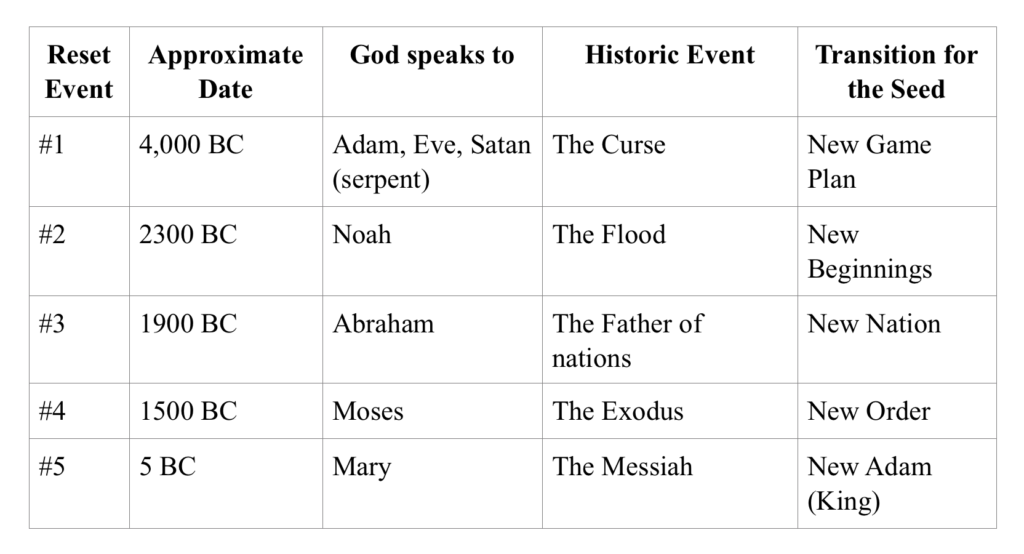
Two redemptive events:
Two climactic, redemptive events are integral to the overall biblical narrative.
The redemption of man: Jesus came to earth to be sacrificed as the Lamb of God, to redeem fallen man. Three days after his cross crucifixion, Jesus was resurrected from the dead. Those who place their complete trust and belief in Him will have their names written in the Lamb’s Book of Life and have eternal life. They too will one day experience a bodily resurrection.
Renewal of the heavens and earth: This event lies ahead of us, following the final judgment and destruction of Satan, his angels, and all those whose names are not written in the Book of Life.
One more time
The Bible spans a history of 4,000 years,
consisting of roughly 70 generations,
organized around 5 key reset events,
to set up 2 climactic redemptive events.
Action for families
By keeping the big picture narrative in mind, relating the Bible to your children can make more sense to them… and to you as parents also. They’ll have a mental container to place the various stories and facts they learn about the Bible.
Here are three ideas for keeping the Biblical narrative front and center in your home
1. Create your own Bible timeline: As a family, chart out the timeline and key reset events on a poster board or flip chart sheet, with colored markers. Practice helping your youth share the biblical narrative, using the language of The Seed. Below is an outline to use as a guide.
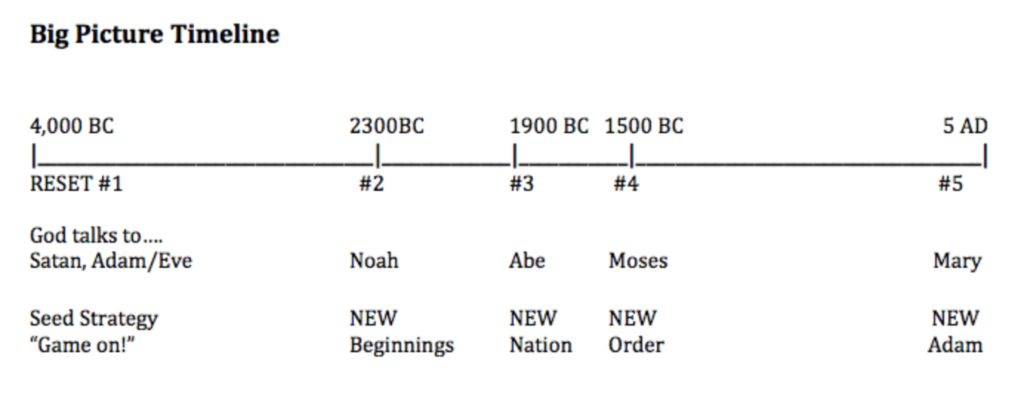
2. In addition to your homemade timelines, you can obtain printed Bible timelines to place in your home that go much deeper in helping to tell the Biblical narrative. Here are three of my favorite posters that I have hanging in my home office. They are very useful reference for my personal Bible study, as well as for sharing with the family.
- https://usstore.creation.com/genealogy-poster
- https://answersingenesis.org/store/product/seven-cs-timeline-poster/?sku=00-5-058
- https://amazingbibletimeline.com
3. Read the Bible regularly as a family, and talk about the narrative along the way.
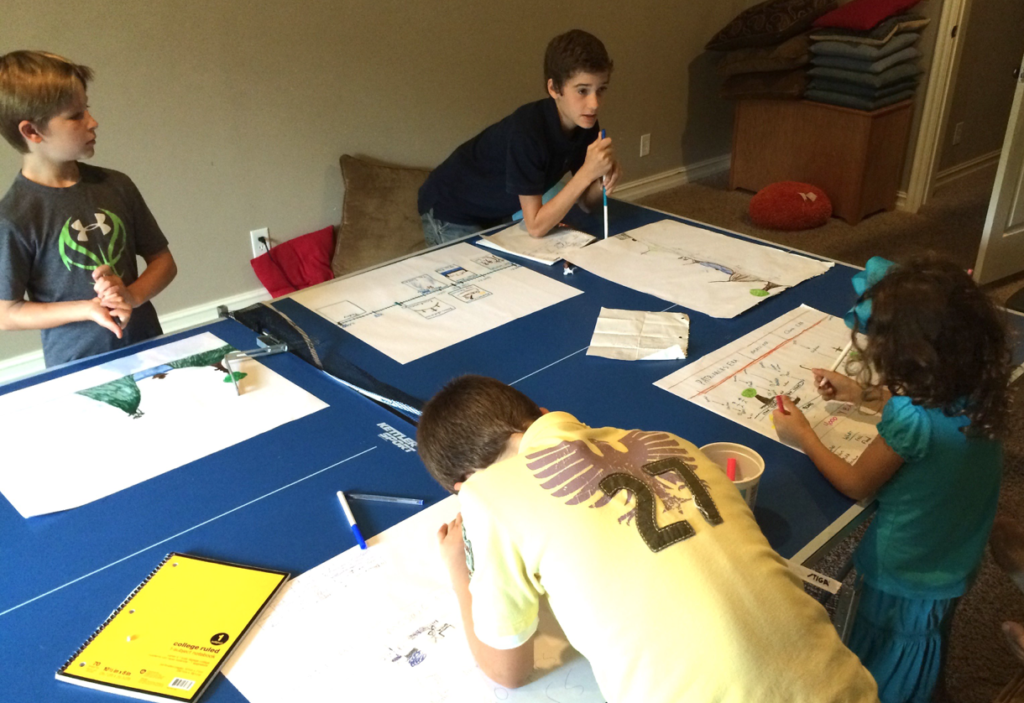
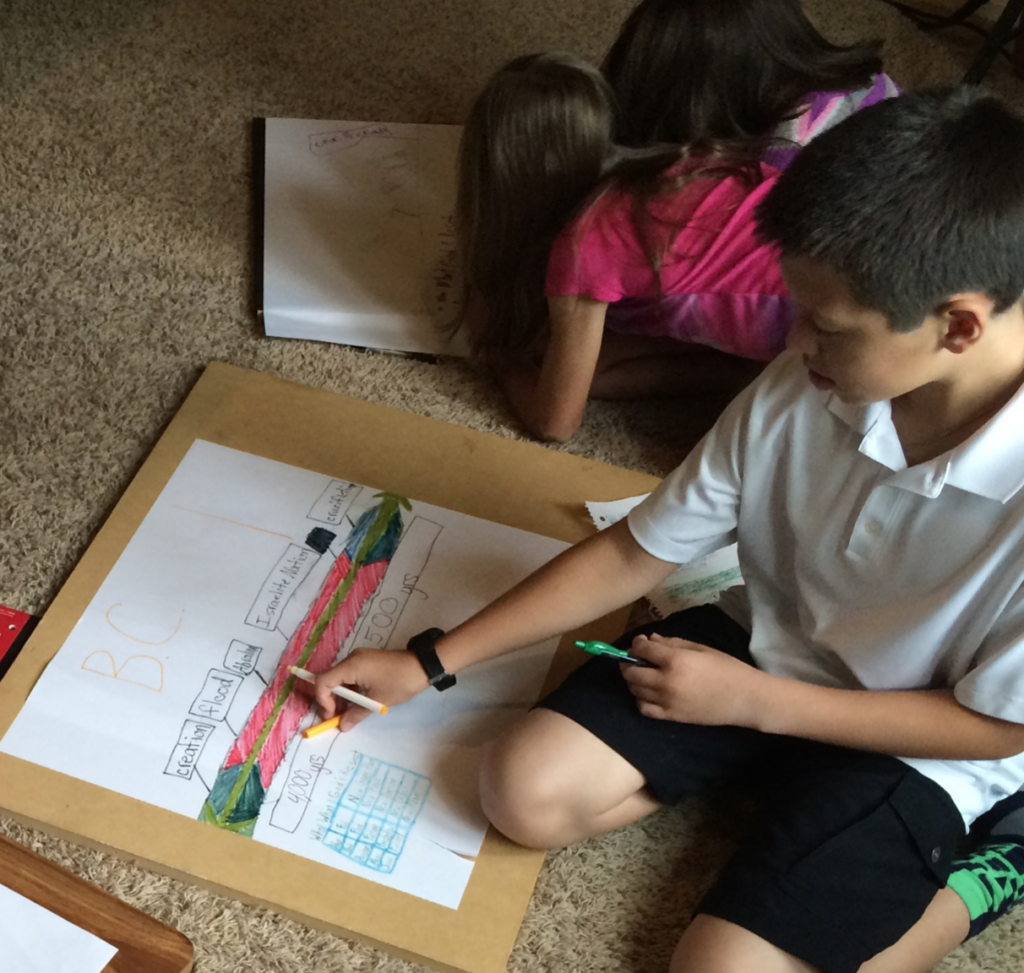
Grown-ups can have fun with this, too! (Below are from a recent class I taught)
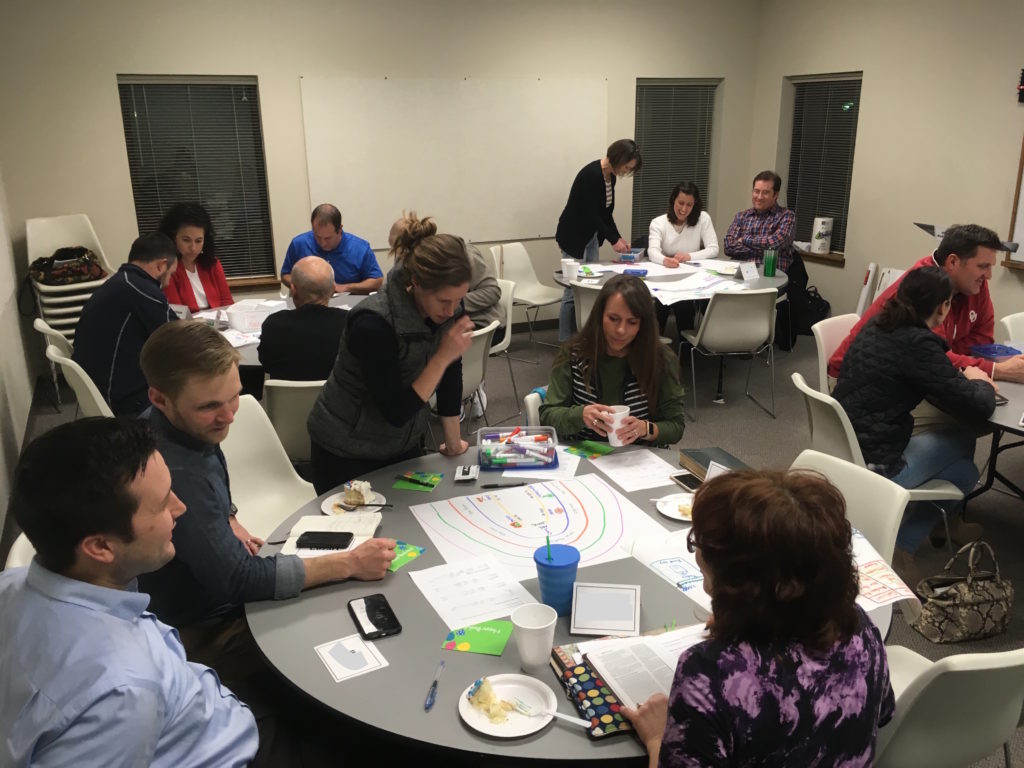

Parents, faith does not transfer automatically.
The enemy is in the business of stealing faith from our youth. It happens easily when they don’t know the big picture. The parable of the seed (Matthew 13) is all about people who hear the truth, and for a while they seem to get it.
But often, for many, something tragic happens. The big picture never develops in their minds or in their hearts. Then distractions come their way…and they drift.
What stops the drift and anchors a soul? Understanding.
Click here to download a PDF to print, read, and share.
Subscribe to my newsletter to receive the next posts!

